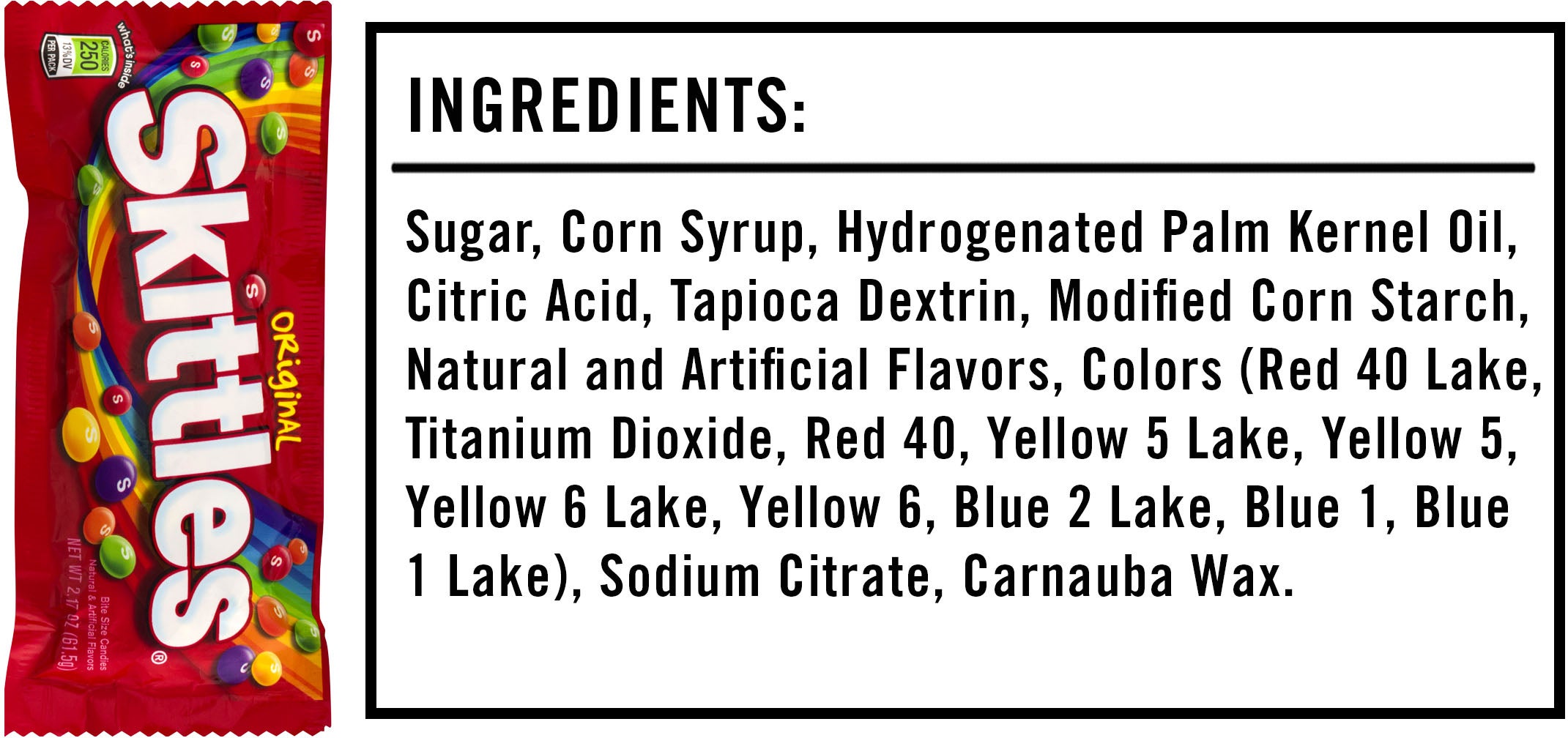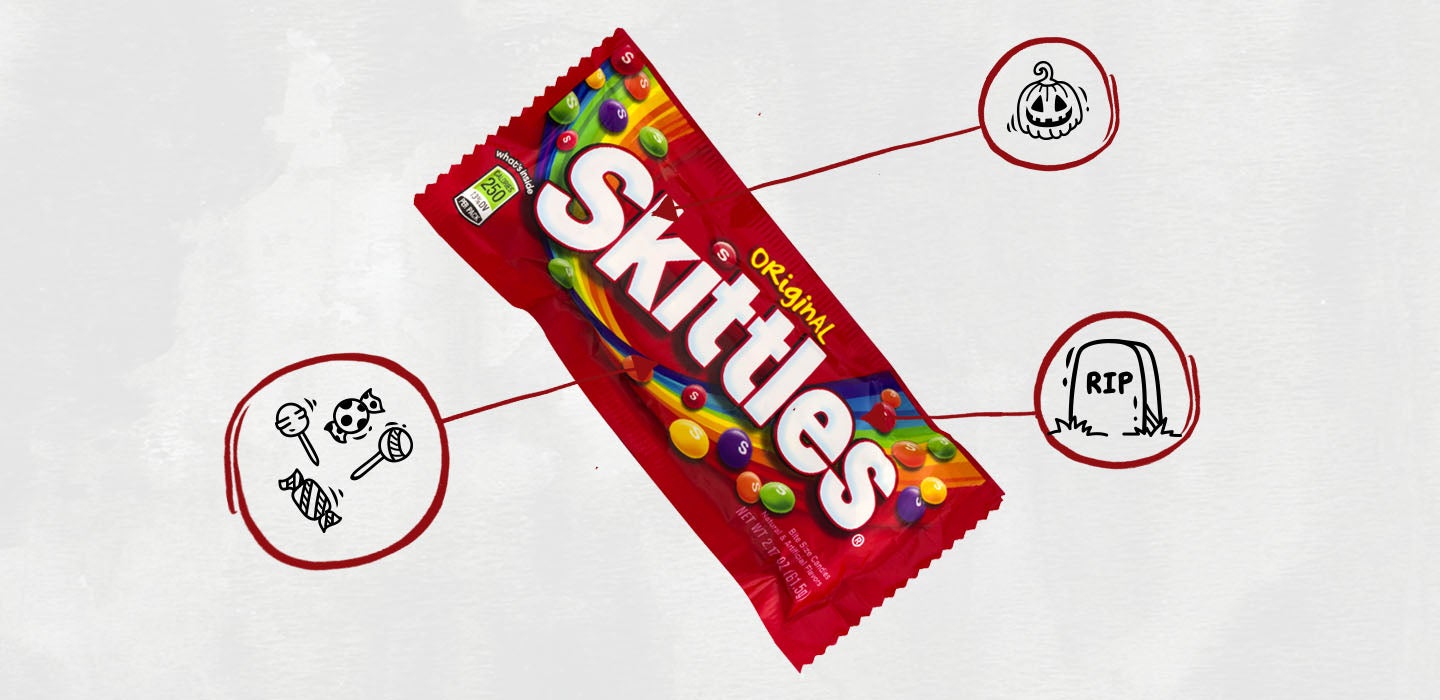We’re often told that you should never eat anything (or put anything on your body) if you don’t recognize everything on the ingredients list. But since most of us have no idea what xanthan gum or potassium benzoate are — or more importantly, what they’re doing to our bodies — we’re decoding the ingredients in the many things Americans put in (and on) themselves with the help of an expert.
This edition: Original Skittles, which are made from 10 separate ingredients that we’ve broken down in the exact order they appear on Amazon, since no nutritional information is listed on the Skittles website.

The Ingredients
1) Sugar: One serving of Skittles contains a whopping 30 grams of sugar ( because a single Skittle reportedly weighs approximately one gram, a serving amounts to about 40 individual Skittles). For reference, the American Heart Association recommends men consume no more than 36 grams and women consume no more than 25 grams of added sugar a day (and that doesn’t include sugar found naturally in foods like fruits and vegetables).
2) Corn Syrup: Corn syrup is a liquid sweetener made of glucose. It doesn’t get as much negative publicity as high fructose corn syrup — which has been linked to obesity and diabetes by many, many studies (more on that here) — but regular corn syrup can also be debilitating, considering it’s basically liquid sugar.
3) Hydrogenated Palm Kernel Oil: According to physician and biochemist Cate Shanahan, author of Deep Nutrition: Why Your Genes Need Traditional Food, consuming too much vegetable oil — which is easy to do, considering Shanahan says roughly 45 percent of the average American’s calories come from refined oils — has serious repercussions (e.g., fatty liver disease, insulin resistance and migraines). But hydrogenated vegetable oil is even worse: When you add hydrogen to food via hydrogenation, which many manufactures do to increase the food’s shelf life, you get trans fats. Unfortunately, trans fats raise cholesterol, harden arteries and inhibit the formation of an enzyme called cyclooxygenase, which helps determine the dilation of your arteries and regulates blood flow.
4) Citric Acid: Citric acid naturally occurs in citrus fruits, and it’s often added to foods to extend their shelf life.
5) Tapioca Dextrin: Dextrin is a starch that’s been broken down by means of chemical reaction, and it’s often used as a carrier for flavorings and colors. As an added bonus, dextrin made from tapioca is gluten-free.
6) Modified Corn Starch: Modified corn starch is treated physically, enzymatically or chemically to partially break down the starch. It can be used as a stabilizer, thickening agent or an emulsifier — that means it helps the numerous ingredients in Skittles mix together.
7) Natural and Artificial Flavors: While natural flavors are literally flavors derived from an actual food source — i.e., grape flavoring taken from a real grap — artificial flavors are chemical compounds created in a lab that mimic a natural flavor in some way. While that may sound unhealthy, as Shanahan told us during our exploration of all 26 ingredients in nacho-flavored Doritos, these flavorings are added in such small quantities that they shouldn’t cause you any harm.
8) Colors (Red 40 Lake, Titanium Dioxide, Red 40, Yellow 5 Lake, Yellow 5, Yellow 6 Lake, Yellow 6, Blue 2 Lake, Blue 1, Blue 1 Lake): Artificial colors have a bad reputation, but as Shanahan explained during our analysis of Doritos, studies arguing this are a bit flawed:
“I’ve always been of the opinion that studies claiming artificial colors can cause cancer are irrelevant because [in the studies] they use really high amounts of the artificial colors — like, a million times more than you’d ever get [in your] food [throughout your lifetime].”
All in all, the average person’s liver should be able to break down whatever minuscule amount of artificial coloring we consume with food.
9) Sodium Citrate: Sodium citrate is the sodium salt of citric acid (a sour flavoring agent and preservative derived from citrus). It acts as a preservative and can provide a sour taste when added in high amounts.
10) Carnauba Wax: “Carnauba wax is a water insoluble substance used as a glazing, bulking and anticaking agent,” Dagan Xavier, ingredient expert and co-founder of Label Insight, told me during my analysis of the ingredients in Orbit White Spearmint Gum. This particular wax is sourced from the copernicia prunifera, a plant grown only in northeastern Brazil.
The Takeaway
Skittles are basically artificially-colored balls of sugar held together with hydrogenated vegetable oil and modified corn starch. Who knew rainbows tasted like an early death?

